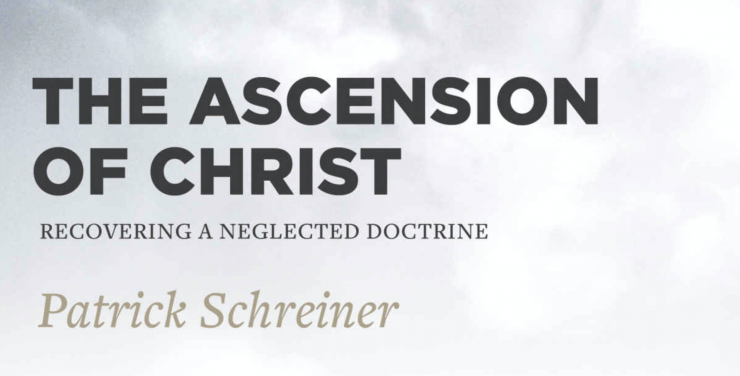Book review: The Ascension of Christ: Recovering a neglected doctrine

The new edition of our theological journal Foundations has just been published. Download the whole issue in pdf format here or read online here.
One of the articles is a book review by Nathan Pomeroy:
The Ascension of Christ: Recovering a neglected doctrine (Patrick Schreiner, Lexham Press, 2020, 127pp)
When Patrick Schreiner wrote this book, he was a professor of New Testament at Western Seminary, Oregon, but has since taken up a similar post at Midwestern Baptist Theological Seminary, Missouri.
The book is in a series called “Snapshots” edited by Michael Bird. It is only 127 pages in length but it is rooted in good biblical and systematic theology. He considers the doctrine of Christ’s ascension “by examining this event from the perspective of the threefold office of the Messiah: prophet, priest, and king (munus triplex)” (xvi). After an overview of the contents I will give three brief comments.
Strictly speaking, it is a book about the ascension and session of Christ: “I will largely view them as a singular script” (xv). The first chapter shows the centrality of the ascension concept throughout the New Testament; though it is narrated in only two places it is through this hinge that “the Bible transitions from the age of Jesus to the age of the church” (13). The early creeds included “…he ascended into heaven” as did the Protestant confessions. “My goal is to help people think through this piece of the Jesus event and impress its importance” (xv).
The book is very easy to read and highly structured, as each chapter on the threefold office of Christ is governed by five repeated sections:
i) Jesus’ earthly ministry viewed under each office
ii) The Old Testament teaching on each office
iii) The OT teaching on the shift in each office from earthly to heavenly
iv) Jesus’ ascension fulfils this shift in each office
v) Jesus’ session fulfils this shift in each office in the life of the church
The ascension of the Prophet; building his church
Here Schreiner limits himself to three aspects of the prophetic role: “prophets were empowered by God’s Spirit, proclaimed the word of God, and performed signs and wonders” (23). He then shows how the Prophet’s ascension is foreshadowed in Adam, Moses and Elijah and that after the ascension event there is a shift in ministry. Applied to Jesus, he writes, “The ascent not only authorizes, but amplifies and multiplies his prophetic work.” (30) Jesus continues to minister as God’s prophet by his Spirit and Word through the church (Eph 4:7-12). “Jesus could say it was better if he left earth (John 16:7) and that his disciples would do greater works than he did (14:12)” (44).
The ascension of the Priest; interceding in heaven
Although the Gospels do not directly refer to Jesus as a priest, there are many allusions to this role, for he came to save his people from their sins, climaxing in the work of the cross. The author again focuses on three aspects of the priest’s role: “priests were chosen from among humanity, acted on behalf of humanity, and offered gifts and sacrifices to God” (50). Moses ascended Sinai, Aaron “ascended” into the Holy of Holies, David ascended the Lord’s hill. Jesus fulfils these shadows as he ascends to heaven, intercedes for us on the basis of his shed blood and pours out his blessing of peace on the church by his Spirit. The church is to engage in priestly service, serving God as living sacrifices, being constant in prayer and “instructing and declaring how people can draw near to God” (72).
Ascension of the King; reigning over all
Though I have argued in each chapter that Christ’s ascent shifted but also sustained Christ’s threefold office, this chapter is unique. While all of the offices are of one piece, kingship is a primary metaphor, and therefore Christ’s kingship stands at the pinnacle. To put this another way, the other offices flow from kingship and this office encompasses the others. (76)
Jesus came as the promised King, and this is prophesied in Psalm 2, Psalm 110 and Daniel 7. A shift took place at the ascension; Jesus was given the throne of heaven with all authority over his enemies and to rule his church.
The final chapter: the ascension in theology
The book before you has been about locating the ascension on the biblical map. I argue the ascension needs better narrative positioning. However, the Messiah’s ascension needs situating not only in terms of the narrative, but in relation to other doctrines Christians confess. Precise theological grammar needs to be employed to correlate Christ’s session to other dogmas. (100)
Schreiner examines how the ascension relates to the Trinity, incarnation, cross, resurrection and eschatology:
· Trinity: “The triune God’s singular will from time before time was to glorify himself… the ascent was an essential event in this design.” (101)
· Incarnation: “Temporal, material, and physical dimensions are therefore not repudiated in the ascension. In the ascension, they are affirmed.” (104)
· Cross: “The Messiah’s ascent therefore confirmed and revealed the truth of Jesus’ cross.” (107)
· Resurrection: The resurrection and ascension are distinct but insep-arable; the first declares that Jesus is alive, the second that he reigns.
· Eschatology: “The Parousia therefore should not be seen as merely something forthcoming, but as something to be revealed that is already present.” (111)
He writes, “To state that the ascension is important is easy, but to state how and in what way it coincides with other doctrines is more challenging but also more rewarding.” (114) “The ascension shifted Christ’s threefold work into a new epoch” (115) – he is prophet, priest and king in heaven. The ascension pushes us to remember not only Jesus’ past ministry but his present and future ministry too.
Patrick Schreiner has written a great doctrinal book that nourishes faith in and love for the Lord Jesus Christ. It is well worth reading.
Comments to stimulate further thought
1. Although Schreiner mentions Revelation 5 in the NT overview, he does not develop this perspective. It would be good to balance the concept of “leaving” earth with the concept of “arriving” in heaven. It is not just that Jesus left earth and arrived in heaven, but that he has taken the scroll; he is enthroned. Revelation 5 is a central passage.
2. Schreiner emphasises the ongoing prophetic ministry of Christ through the Word, the Scriptures (35-37). But he surprisingly makes no mention of the giving of the New Testament Scriptures. At the ascension they did not exist, and their production is the work of the exalted Christ. This should surely be emphasised, alongside the ongoing testimony of Christ through the Old Testament.
3. In several place Schreiner talks about heaven (32, 59, 61) and states that “heaven is not a locality in the way we think of dwellings” and “Scripture portrays heaven as much as a state as a locality”. I found this unconvincing; heaven is a created place where God and created beings exist. He affirms in a footnote, “traditional reformed thinkers have argued heaven is a created location”. Another confusion seems to be asserted when he states, “When Jesus went to heaven he moved from the old creation to the new creation.” The present heaven is not the new creation; it will be transformed on the last day in its union with the physical earth, when there will be new heavens and a new earth.
Nathan Pomeroy, Pastor, Arnold Road Evangelical Church, Nottingham
Stay connected with our monthly update
Sign up to receive the latest news from Affinity and our members, delivered straight to your inbox once a month.



